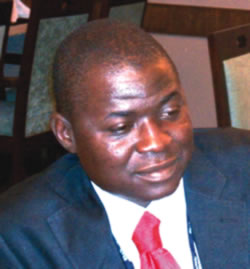Stroke: All you need to know
Dr. Biodun Ogungbo
Stroke
is the acute and dramatic onset of focal or global neurological
deficit, which is most often caused by interruption of the blood supply
to the brain or, indeed, bleeding into brain tissue.
What is the state of stroke among Nigerians? Is it on the increase or decreasing because of awareness from government?
The incidence of stroke is increasing
worldwide. Stroke is now the second leading cause of death in most
industrialised countries among adults aged 65 and above. It does seem
that stroke is affecting younger people in Nigeria. A study and
anecdotal evidence suggest that stroke principally affects middle-aged
women, with increasing cases of stroke among young Nigerians. Most of
the patients we see are between 40 and 60 years old.
In your estimation, what’s the number of Nigerians with stroke?
We do not know the actual number of
Nigerians suffering a stroke each year. But we can estimate. The
population of Nigeria exceeds 168,833,379 million people. If we assume
an average stroke incidence of 116 per 100,000 of the population in
Nigeria, then 195,846 people suffer a stroke in Nigeria yearly. Using
figures from Sagamu, Ogun State, it can be estimated that roughly 34 per
cent (n=59,160) will die within a month and 60 per cent (n=118,320)
within six months.
What are the danger signs before someone gets a stroke?
Transient ischemic attack is the name
for a mild stroke. This is a harbinger of death and a warning sign of
impeding major stroke. People who have a mild stroke are at increased
risk of having a major stroke within the year. They are the best people
to see and treat in hospitals because doctors can then make great
efforts to identify why they have had a mini stroke and do all they can
to prevent a bigger stroke.
It is important to recognise and
diagnose a patient with TIA. Confusion, blurring of vision, speech
impairment, difficulty walking and weakness of an arm or a leg are
possible pointers to impending major stroke.
How can one avoid getting stroke?
Identifying patients with hypertension,
diabetes, obesity, smokers, sickle cell patients and those with a strong
family history of stroke is very important. These people are at risk of
stroke and so must change their lifestyles or go on medications to
prevent stroke.
Hypertension is the single most
important cause of stroke and the one that is eminently reducible by
treatment. It has been estimated that between 52 and 70 per cent of
stroke patients have hypertension. Up to 60 per cent of patients have
undiagnosed high blood pressure prior to presentation. Reduction of high
blood pressure substantially reduces stroke risk.
It is the duty of every clinician or nurse to at least check the BP of all adults they are reviewing for any health problem.
How can stroke be treated first hand before a patient is taken to the hospital?
Prevention is important. Next to that is
early presentation to hospital. ‘Brain attack’ is a term that has been
coined to emphasise the need for URGENT action. Studies have shown that
delays in presentation are caused mostly by lack of awareness of stroke.
Stroke victims MUST be taken to hospital immediately.
There’s so much myth surrounding it; how true is it that it is caused by enemies or evil spirits?
The idea that somebody hates you and
therefore wished stroke on you is one of the major impediments to early
presentation of stroke victims for treatment. We must keep emphasising
that stroke occurs in the brain due to lack of blood going to the brain.
It is not due to witches or witchcraft and cannot be ‘sent’ by one
person to another. It occurs in people with risk factors for stroke who
have not looked after themselves.
How can government dispel this myth?
Public awareness programmes are
important. Information about stroke should be made widely available to
the public. The local press, celebrities and television personalities
should be educated on the risks of stroke and the importance of wide
public awareness. Stroke issues should be introduced in schools,
churches, mosques, on television, in the theatre and brought to national
attention.
What’s the achievement of Stroke Action, Nigeria so far?
Stroke Action, Nigeria convened the
first ‘Stroke Assembly’ in Nigeria last year, and it generated massive
public awareness about stroke. People now know that stroke is no longer
an untreatable condition.
Stroke Action, Nigeria has started the
active recruitment of Stroke Ambassadors to cover every nook and cranny
of the country. These ambassadors are empowered to spread the news about
stroke and educate the wider public. We also evaluate strategies to
enlist the support of politicians and the general public in stroke
awareness.
The public (You!) must, in return, help Stroke Action, Nigeria by
- Supporting and sponsoring Stroke Action, Nigeria’s ‘Stroke Outreach Programmes’
- Investing ‘seed finance’ for capacity building to establish a pilot Stroke Action ‘Life After Stroke’ centre,
- Supporting the sustainability of the service, and subsequent efforts to reduce the incidence of stroke.
We need your help physically, morally
and financially to reduce the incidence of stroke in Nigeria, by
creating much awareness about this dreadful disease. Call or email me
for more information on how you can help locally.
For donations, please make payments to:
Account Name: Stroke Action LTD/GTE
Diamond Bank: Acct No. 0029726120 (giving your office/name as a reference).
Culled from Punch


Comments
Post a Comment